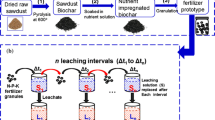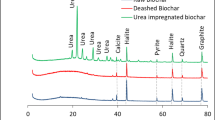Abstract
In this study, the nitrogen-releasing characteristics and mechanism of the biochar-based urea infiltration fertilizer (BUF) were investigated. The crushing resistance of BUF increased with the increased proportion of urea-biochar, which at maximum reached 502.93 ± 6.47 N. BUF had the excellent slow-release performance. Urea was completely released after third leaching, while the urea in BUF1-2 was not completely released after tenth leaching. The release process of BUF1-2 is divided into three stages, which corresponded to the release of P-urea (dispersed on the biochar surface without physic force and chemical bonds), F-urea (connected with biochar through intermolecular forces, hydrogen bonds, etc.), and C-urea (connected with biochar through chemical bonds) in BUF1-2. The release rate of P-urea, F-urea, and C-urea decreased gradually. Moreover, the physicochemical performances of biochar and Re biochar were similar, although their apparent morphologies were different. The pores of biochar filled with urea collapsed in the nitrogen-release process, reducing the number of pores on Re-biochar surface. As a new type of biochar-based fertilizer, its effects on soil improvement, crop yield increase, and fertilization methods still need to be further studied.








Similar content being viewed by others
Data availability
All the data in this paper are from the author’s original, and some of the cited data have been marked in the paper.
References
Ye H, Li H, Wang C et al (2020) Degradable polyester/urea inclusion complex applied as a facile and environment-friendly strategy for slow-release fertilizer: performance and mechanism. Chem Eng J 381. https://doi.org/10.1016/j.cej.2019.122704
Liu JL, Yang YC, Gao B et al (2019) Bio-based elastic polyurethane for controlled release urea fertilizer: fabrication, properties, swelling and nitrogen release characteristics. J Clean Prod 209:528–537. https://doi.org/10.1016/j.jclepro.2018.10.263
Zheng JF, Han JM, Liu ZW et al (2017) Biochar compound fertilizer increases nitrogen productivity and economic benefits but decreases carbon emission of maize production. Agric Ecosyst Environ 241:70–78. https://doi.org/10.1016/j.agee.2017.02.034
Gu B, Sutton MA, Chang SX et al (2014) Agricultural ammonia emissions contribute to China’s urban air pollution. Front Ecol Environ 12:265–266. https://doi.org/10.1890/14.WB.007
Lu C, Tian H (2017) Global nitrogen and phosphorus fertilizer use for agriculture production in the past half century: shifted hot spots and nitrogen imbalance. Earth Syst Sci Data 9:181–192. https://doi.org/10.1890/14.WB.007
Kanter D, Searchinger T (2018) A technology-forcing approach to reduce nitrogen pollution. Nat Sustain 1:544–552. https://doi.org/10.1038/s41893-018-0143-8
Gonzalez-Cencerrado A, Pallares Ranz J, Lopez-Franco Jimenez MT et al (2020) Assessing the environmental benefit of a new fertilizer based on activated biochar applied to cereal crops. Sci Total Environ 711. https://doi.org/10.1016/j.scitotenv.2019.134668
Shi W, Ju Y, Bian R et al (2020) Biochar bound urea boosts plant growth and reduces nitrogen leaching. Sci Total Environ 701. https://doi.org/10.1016/j.scitotenv.2019.134424
Naz M, Sulaiman S (2016) Slow release coating remedy for nitrogen loss from conventional urea: a review. J Control Release 225:109–120. https://doi.org/10.1016/j.jconrel.2016.01.037
Qiu M, Sun K, ** J et al (2015) Metal/metalloid elements and polycyclic aromatic hydrocarbon in various biochars: the effect of feedstock, temperature, minerals, and properties. Environ Pollut 206:298–305. https://doi.org/10.1016/j.envpol.2015.07.026
Wang X, Gao C, Xu X et al (2014) Biomass-based multifunctional fertilizer system featuring controlled-release nitrogen, water-retention and amelioration of soil. RSC Adv 4(35):18382–18390. https://doi.org/10.1039/c4ra00207e
Li H, Xu H, Zhou S et al (2018) Distribution and transformation of lead in rice plants grown in contaminated soil amended with biochar and lime. Ecotoxicol Environ Saf 165:589–596. https://doi.org/10.1016/j.ecoenv.2018.09.039
Wang Y, Dang F, Zheng X et al (2019) Biochar amendment to further reduce methylmercury accumulation in rice grown in selenium-amended paddy soil. J Hazard Mater 365:590–596. https://doi.org/10.1016/j.jhazmat.2018.11.052
Yu Z, Qiu W, Wang F et al (2017) Effects of manganese oxide modified biochar composites on arsenic speciation and accumulation in an indica rice (Oryza sativa L.) cultivar. Chemosphere 168:341–349
** W, Wang Z, Sun Y et al (2020) Impacts of biochar and silicate fertilizer on arsenic accumulation in rice (Oryza sativa L.). Ecotox Environ Safe 189. https://doi.org/10.1016/j.ecoenv.2019.109928
Wang JM, Liu W, Liu ZW et al (2020) Effects of biochar application on soil organic carbon mineralization in paddy fields with different depths. Agric Environ Sci 39:2081–2088 ((In Chinese with English abstract))
Latawiec AE, Strassburg BBN, Junqueira AB et al (2019) Biochar amendment improves degraded pasturelands in Brazil: environmental and cost-benefit analysis. Sci Rep-UK 9. https://doi.org/10.1038/s41598-019-47647-x
Fowles M (2007) Black carbon sequestration as an alternative to bioenergy. Biomass Bioenerg 31:426–432. https://doi.org/10.1016/j.biombioe.2007.01.012
Borges BMMN, Strauss M, Camelo PA et al (2020) Re-use of sugarcane residue as a novel biochar fertiliser-increased phosphorus use efficiency and plant yield. J Clean Prod 262. https://doi.org/10.1016/j.jclepro.2020.121406
Marris E (2006) Putting the carbon back: black is the new green. Nature 442:624–626. https://doi.org/10.1038/442624a
Steinbeiss S, Gleixner G, Antonietti M et al (2009) Effect of biochar amendment on soil carbon balance and soil microbial activity. Soil Biol Biochem 41:1301–1310
**ang A, Qi R, Wang M et al (2020) Study on the infiltration mechanism of molten urea and biochar for a novel fertilizer preparation. Ind Crop Prod 153. https://doi.org/10.1016/j.indcrop.2020.112558
Ding X, Liu B, Niu J (2006) Determination of urea content in the slow-release urea. Chemical Fertilizer Industrial 03:35–36
Noordin N, Ghazali N (2018) Impact of sap-biochar incorporation on controlled release water retention fertilizer (CRWR) towards growth of okras (Abelmoschus Esculentus). Mater Today Proc 5(10):21911–21918. https://doi.org/10.1016/j.matpr.2018.07.050
LeCroy C, Masiello R et al (2013) Nitrogen, biochar, and mycorrhizae: alteration of the symbiosis and oxidation of the char surface. Soil Biol Biochem 58:248–254. https://doi.org/10.1016/j.soilbio.2012.11.023
Dünisch O, Lima V, Seehann G et al (2007) Retention properties of wood residues and their potential for soil amelioration. Wood Sci Technol 41:169–189. https://doi.org/10.1007/s00226-006-0098-1
Huong P, Lee B, Kim J et al (2016) Acid activation pine cone waste at differences temperature and selective removal of Pb2+ ions in water. Process Saf Environ 100:80–90. https://doi.org/10.1016/j.psep.2015.12.002
Chen J, Fan X, Zhang L et al (2020) Research progress in lignin-based slow/controlled release fertilizer. Chemsuschem 13:4356–4366. https://doi.org/10.1002/cssc.202000455
Funding
This work was financially supported by the National Natural Science Foundation of China (grant number 51706074) and the Bureau of Guangdong Forestry (grant number 2020KJCX008).
Author information
Authors and Affiliations
Contributions
Mingfeng Wang: conceptualization, methodology, investigation, project administration, and formal analysis. Aihua **ang: methodology, writing—original draft preparation, formal analysis. Zhennan Gao: methodology. Enchen Jiang: supervision. Yongzhi Ren: resources. Zhifeng Hu: data curation.
Corresponding authors
Ethics declarations
Ethics approval
Not applicable.
Consent to participate
In this paper, all authors have agreed and confirmed their participation.
Consent for publication
All authors agree to publish this research.
Competing interests
The authors declare no competing interests.
Additional information
Publisher’s note
Springer Nature remains neutral with regard to jurisdictional claims in published maps and institutional affiliations.
Mingfeng Wang and Aihua **ang are contributed equally to this work and should be considered as joint first authors
Rights and permissions
About this article
Cite this article
Wang, M., **ang, A., Gao, Z. et al. Study on the nitrogen-releasing characteristics and mechanism of biochar-based urea infiltration fertilizer. Biomass Conv. Bioref. 13, 9795–9805 (2023). https://doi.org/10.1007/s13399-021-01848-5
Received:
Revised:
Accepted:
Published:
Issue Date:
DOI: https://doi.org/10.1007/s13399-021-01848-5




